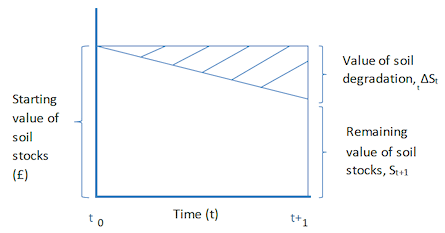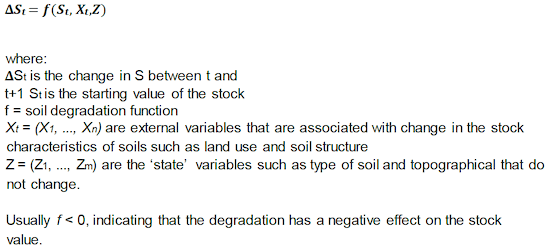Developing a method to estimate the costs of soil erosion in high-risk Scottish catchments: final report
Report from a project which developed and used an ecosystem service framework approach to estimate the costs of soil erosion in Scotland, for five study catchments.
5. Framework for the economic costs of soil erosion in scotland
Soils are natural capital assets. Soil stocks, described in terms of their quantities and qualities have potential to provide a range of benefits to people in the form of ecosystem services. Whilst soil quantity and quality determine the ability of soils to provide these benefits, their contextual attributes such as altitude, topography, climate, hydrology and location are also important. The misuse of soil natural capital assets in pursuit of benefit can, however lead to their degradation, resulting in loss of benefit or increased costs.
It is impossible to determine the full value of soil stocks. Soils deliver many monetary (e.g. crop production) and non-monetary benefits (e.g. landscape aesthetics and feelings of wellbeing) to individuals and society as a whole, as shown in Table 1. Some of these benefits are tangible (yet still can be non-monetary), others are intangible. It is possible, however, to determine the variations in the condition of stocks of soils (e.g. the degree of degradation of soils assets due to soil erosion) and the likely implications for flows of services. This is the approach adopted here, using the ecosystem service framework, by estimating the change in the value of annual service flows, that is the annual costs of the degradation of soil stocks due to soil erosion by water.
5.1. Soils stocks and flows of ecosystems goods and services
The loss of soil stock through erosion over time leads to a decline in the value stock of soil assets and a reduction in the value of future services provided by them. In other words, soil erosion leads to the depreciation of a physical asset (soil as a natural capital asset), evident in the reduction of its remaining value over time. Thus in Figure 8, degradation is the reduction in the value of soil (in delivering services) over an accounting period, equivalent to the depreciation of physical assets. Degradation, if continued and unabated, would eventually lead to complete loss of soil assets and the services they deliver.

The stock: flow relationship can be expressed as a difference equation as follows:

Then:

Or


Where T = time at the end point of running the model (years) (T-1 represents Year 1 - Year n, where Year n is the end point of the model run)
The value of the soil resource at any point in time is a function of its initial value and the cumulative effects of degradation (e.g. soil erosion processes) over time. If, however, as often might be the case, there is an interaction between the stock itself (i.e. soil) and the rate of degradation of that stock (e.g. thin, eroded soils are more susceptible to further erosion due to loss of structure and organic matter) then a more complex relationship applies.
From an economist’s perspective, the value of a stock at a point in time is determined by the present value of the future flows of services, discounted at the social discount rate[1]. Thus a change in the stock value is indicated by the change in the present value of flows of services rendered. For example: the reduction in carbon content of soils associated with emissions to atmosphere results in costs borne by society measured at the social cost of carbon. The present value sum of these emissions can indicate a decline in the value of soil carbon stocks between any two points in time. A similar approach can be used in principle for the value of soils as a medium for food production. It is noted however that some degraded services may be substituted by other ‘replacement’ inputs, such as artificial fertilisers. This does not reduce the loss of stock value. Rather it substitutes the natural functions of soil at an additional cost.
5.2. The counterfactual ‘without degradation’ situation
It is required to define a baseline ‘counterfactual’ situation against which the economic costs of soil degradation can be ascertained. The counterfactual is the condition of soils, both in terms of stock and flow values, which would prevail in the absence of degradation,

The degradation that arises from the particular land use is identified together with the costs of degradation associated with that particular land use. As explained below, the analysis focuses on loss of value added and additional costs, whether associated with substitution of soil properties or mitigation to prevent their loss.
5.3. Classifying the costs of soil degradation
An ecosystem services framework is adopted here to assess the economic costs of different processes of soil degradation. Many of the services provided by soils are intermediate supporting services that underpin provisioning, regulating and cultural services. Emphasis is placed on the generation of ‘final goods’ that are of value to people.
Consistent with other classification approaches, these final goods incorporate on-site and offsite effects, private and public benefits, as well as use and non use benefits (Table 13). Soil degradation results in a reduction in the quantity and quality of soil as natural capital and hence a reduction in the quantity and quality of flows of ecosystem services. These changes in stocks and flows are expressed in economic terms where possible.
| Spatial extent | Type of cost | Ecosystems services perspective | Economic perspective | Basis for valuation |
|---|---|---|---|---|
| On site: | Productivity loss, Damage costs Mitigation costs |
Mainly provisioning services e.g. agricultural production Some supporting services e.g. providing habitats and media for flora, nutrient cycling etc. Cultural services to onsite users |
Mainly ‘private’ costs borne by individuals and organisations Some non market costs borne by site users |
Mainly market prices Non market prices for uncompensated site users |
| Offsite: | Damage costs Mitigation costs. | Mainly regulation e.g. flood control, GHG regulation and cultural services e.g. recreational (swimming, fishing, boating), property values |
Public costs borne by society at large Some private costs e.g. water treatment |
Combination of market and nonmarket prices Non-monetary (intangible) impacts |
| Total | Combined on- and off site | Combined value of provisioning, regulating and cultural services | Combined value of private and public costs | Mix of market prices (adjusted for taxes and subsidies) and non market prices. Non monetary (intangible) impacts |
The identified and quantifiable costs of erosion include:
- the annual onsite costs of the decline in agricultural and forestry yields caused by the reduction in soil depth, and the cost of replacing losses in C, N, P and K. The economic analysis was unable to account for the on-site costs of soil erosion mitigation measures at the catchment and national scale. Although costs of mitigation have been reported in the Literature Review, they cannot be included in the economic analysis at the catchment or national scale, because there is no information on the numbers of measures used or their geographical location. This would require mapping these measures at a much finer resolution than used in the present study (e.g. location of field buffer strips; identification of minimum tillage use; etc.).
- the annual offsite costs associated with impacts on environmental water quality (e.g. ‘good ecological status’ in the Water Framework Directive), drinking water quality, and greenhouse gas regulation. Onsite costs accrue at the location of the degradation processes. They are mainly (but not exclusively) borne by those causing degradation and as such are mainly ‘private’ costs to individuals and organisations. Offsite costs accrue elsewhere and are borne by third parties, usually without compensation, and are therefore mainly public/societal costs. Some on-site costs may be public costs that accrue to users, such as walkers in the countryside, whose non market benefits are reduced without compensation (assuming they cannot go elsewhere to derive the same net benefit).
The majority of onsite private costs can be valued using market prices. The valuation of offsite, public costs may involve a mix of market and non-market prices. It is noted, however, that onsite costs may include some non-market costs, such as the stress or loss of amenity or reputation caused by a degradation process, such as a serious soil erosion incident on farm land.
From an economic viewpoint the cost of soil degradation is the sum of onsite and offsite costs (with some adjustments to market prices to remove the effect of taxes and subsidies). Evidence to date suggests that offsite costs exceed onsite costs by a large margin (Graves et al., 2015), and that the onsite benefits of soil erosion control (mitigation) may be less than the costs involved (Posthumus et al., 2013a). This might not, however, be the case from the public perspective, because the benefits of soil conservation are accrued to others besides the land manager / farmer who will implement these measures on their land. It is difficult to predict the ratio of on-site to off-site costs and benefits, as this will vary over both time (e.g. changing prices and costs) and space (soil erosion is very localised in extent) (Posthumus et al., 2013a). Thus, much of soil policy is concerned with identifying total costs of soil degradation, and where appropriate, using cost effective policy measures to reduce degradation in the public interest. This may involve a mixture of regulatory, economic and voluntary instruments.
Contact
Email: resasadmin@gov.scot
There is a problem
Thanks for your feedback